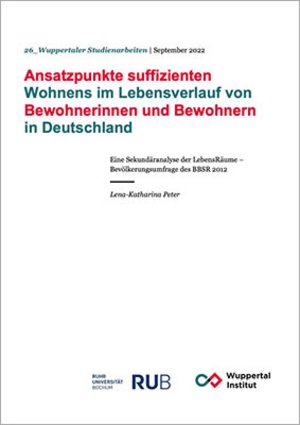Ansatzpunkte suffizienten Wohnens im Lebensverlauf von Bewohnerinnen und Bewohnern in Deutschland
Eine Sekundäranalyse der LebensRäume – Bevölkerungsumfrage des BBSR 2012

For some years now, housing in Germany has been determined by two significant development trends: First, the average household size is decreasing, and second, the average per capita living space is increasing. As a result, demand for housing is rising significantly, leading to higher rents and unequal distribution processes of the housing stock, especially in urban areas. So far, this increasing demand for housing has been met in many places by expanding new construction, but this is associated with faster consumption of valuable and limited land resources. A concept that has only recently been discussed as a possible answer to the current social and ecological challenges of housing is so-called sufficiency housing. This involves the fundamental question of how much living space is needed to adequately meet the respective needs of a household and how to respond to a change in these needs by making better use of the existing building stock. Sufficiency-based housing concepts thus aim both to address individual housing needs and to avoid further surface sealing.
This master thesis aims to highlight the potential of sufficiency housing in the context of current societal, ecological, and housing policy challenges. In this context, the consideration of changing housing needs in the life course of individuals plays a central role, since at certain turning points there is often a subjective under- or oversupply of living space. By means of a hierarchical-agglomerative cluster analysis and the representative "LebensRäume" – population survey of the BBSR, a total of eight housing types are identified, which differ according to life course phase and housing situation. In addition to relevant turning points in the residential biographies of individuals, this also reveals the outstanding importance of home ownership for the average per capita living spaces in the different clusters. Regarding the support of sufficiency housing in Germany, two central analysis results can be formulated. On the one hand, the move-out of children, retirement and widowhood create important opportunities for changing housing situations. On the other hand, the influence of home ownership must be seen as an opportunity to enable a more sufficiency-oriented way of living by making changes to the housing stock.
Lena-Katharina Peter:
Ansatzpunkte suffizienten Wohnens im Lebensverlauf von Bewohnerinnen und Bewohnern in Deutschland
Eine Sekundäranalyse der LebensRäume – Bevölkerungsumfrage des BBSR 2012
Wuppertal 2022, ISBN 978-3-946356-29-5
(Wuppertaler Studienarbeiten zur nachhaltigen Entwicklung no. 26)
